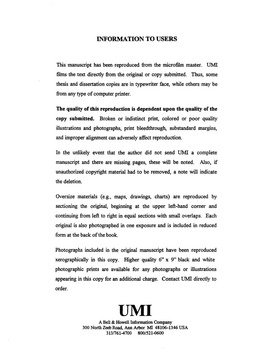| dc.contributor.advisor | Gross, David, | en_US |
| dc.contributor.author | Cowlishaw, Brian Thomas. | en_US |
| dc.date.accessioned | 2013-08-16T12:30:03Z | |
| dc.date.available | 2013-08-16T12:30:03Z | |
| dc.date.issued | 1998 | en_US |
| dc.identifier.uri | https://hdl.handle.net/11244/5642 | |
| dc.description.abstract | Finally, in the Victorian era, the eccentric lost yet more cultural power and even began to disappear. Eccentricity was idealized by many, but this only made the eccentric seem a mere (and foolish) idealist. Additionally, the concept blurred with concepts of madness and philanthropy; "the eccentric" became more one of those other figures than an entity unto himself. Thus he became the familiar harmless clown that we recognize today. | en_US |
| dc.description.abstract | Between 1740 and 1800, eccentricity came to seem paradoxically more and less acceptable, as it was generally seen as a minor form of mental illness. Blame was not so much attached, but as an illness it could not be unqualifiedly welcomed, either. | en_US |
| dc.description.abstract | My dissertation traces the concept of "the eccentric" in Great Britain from its early eighteenth-century beginnings through the end of the Victorian era, by which time it took essentially the same shape we recognize today. This figure is generally thought to be timeless and "natural, " but this is not actually the case; the figure has a history that also touches other important histories such as those of madness, gender, class, science, and social control. Because there is no significant body of literature which directly addresses eccentricity, I approach the subject indirectly, examining relevant works such as The Spectator, Tristram Shandy, The Female Quixote, early nineteenth-century "physiologies, " De Quincey's Confessions, Frankenstein, the novels of Dickens and Gissing, and related legal, scientific, and medical texts. | en_US |
| dc.description.abstract | In the Romantic era, the noun "eccentric" first entered the language; by then it had become a concept that was stable and widely shared enough to have a name. However, this time also saw the eccentric's potentially subversive power contained, as the society-wide scientific urge to catalogue, classify, and dominate also reached the eccentric. | en_US |
| dc.description.abstract | I argue that the eccentric originated in response to the Augustan dichotomy of reason and madness; he offered a very limited third alternative. Sir Roger de Coverley of The Spectator, modeled closely after Cervantes's character Don Quixote, is an early positive example. | en_US |
| dc.format.extent | v, 315 leaves : | en_US |
| dc.subject | Eccentrics and eccentricities. | en_US |
| dc.subject | Eccentrics in literature. | en_US |
| dc.subject | Literature, English. | en_US |
| dc.title | A genealogy of eccentricity. | en_US |
| dc.type | Thesis | en_US |
| dc.thesis.degree | Ph.D. | en_US |
| dc.thesis.degreeDiscipline | Department of English | en_US |
| dc.note | Source: Dissertation Abstracts International, Volume: 59-04, Section: A, page: 1174. | en_US |
| dc.note | Major Professor: David Gross. | en_US |
| ou.identifier | (UMI)AAI9828795 | en_US |
| ou.group | College of Arts and Sciences::Department of English | |
